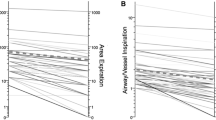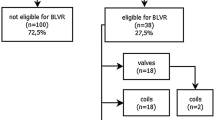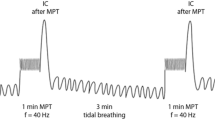Abstract
Objectives
To assess the impact of endobronchial coiling on the segment bronchus cross-sectional area and volumes in patients with lung emphysema using quantitative chest-CT measurements.
Materials and methods
Thirty patients (female = 15; median age = 65.36 years) received chest-CT before and after endobronchial coiling for lung volume reduction (LVR) between January 2010 and December 2014. Thin-slice (0.6 mm) non-enhanced image data sets were acquired both at end-inspiration and end-expiration using helical technique and 120 kV/100–150 mAs. Clinical response was defined as an increase in the walking distance (Six-minute walk test; 6MWT) after LVR-therapy. Additionally, pulmonary function test (PFT) measurements were used for clinical correlation.
Results
In the treated segmental bronchia, the cross-sectional lumen area showed significant reduction (p < 0.05) in inspiration and tendency towards enlargement in expiration (p > 0.05). In the ipsilateral lobes, the lumina showed no significant changes. In the contralateral lung, we found tendency towards increased cross-sectional area in inspiration (p = 0.06). Volumes of the treated segments correlated with the treated segmental bronchial lumina in expiration (r = 0.80, p < 0.001). Clinical correlation with changes in 6MWT/PFT showed a significant decrease of the inspiratory volume of the treated lobe in responders only.
Conclusion
Endobronchial coiling causes significant decrease in the cross-sectional area of treated segment bronchi in inspiration and a slight increase in expiration accompanied by a volume reduction.
Key Points
• Endobronchial coiling has indirect impact on cross-sectional area of treated segment bronchi
• Volume changes of treated lobes correlate with changes in bronchial cross-sectional area
• Coil-induced effects reflect their stabilizing and stiffening impact on lung parenchyma
• Endobronchial coiling reduces bronchial collapsing compensating the loss of elasticity





Similar content being viewed by others
References
Zhang WJ, Hubbard Cristinacce PL, Bondesson E et al (2015) MR quantitative equilibrium signal mapping: A reliable alternative to CT in the assessment of emphysema in patients with chronic obstructive pulmonary disease. Radiology 275:579–588
Sasaki H, Nakumura M, Takishma T (1976) Effect of lung parenchyma on bronchial collapsibility during maximum expiratory flow in dogs. Tohoku J Exp Med 118:1–10
Choi M, Lee WS, Lee M et al (2015) Effectiveness of bronchoscopic lung volume reduction using unilateral endobronchial valve: A systematic review and meta-analysis. Int J Chron Obstruct Pulmon Dis 10:703–710
Gompelmann D, Eberhardt R, Herth FJ (2013) Endoscopic lung volume reduction. A european perspective. Ann Am Thorac Soc 10:657–666
Grosse U, Hetzel J, Gundel L et al (2014) Impact of endobronchial coiling for lung volume reduction on pulmonary volume and attenuation: Preinterventional and postinterventional computed tomography-quantification using separate lobe measurements. J Comput Assist Tomogr 38:779–785
Kontogianni K, Gerovasili V, Gompelmann D et al (2014) Effectiveness of endobronchial coil treatment for lung volume reduction in patients with severe heterogeneous emphysema and bilateral incomplete fissures: A six-month follow-up. Respiration 88:52–60
Duerig TW, Pelton AR, Stockel D (1996) The utility of superelasticity in medicine. Biomed Mater Eng 6:255–266
Shabalovskaya SA (2002) Surface, corrosion and biocompatibility aspects of nitinol as an implant material. Biomed Mater Eng 12:69–109
Miller MR, Crapo R, Hankinson J et al (2005) General considerations for lung function testing. Eur Respir J 26:153–161
Murgu S, Colt H (2013) Subjective assessment using still bronchoscopic images misclassifies airway narrowing in laryngotracheal stenosis. Interact Cardiovasc Thorac Surg 16:655–660
Murgu SD, Colt HG (2007) Description of a multidimensional classification system for patients with expiratory central airway collapse. Respirology 12:543–550
Baroni RH, Feller-Kopman D, Nishino M et al (2005) Tracheobronchomalacia: Comparison between end-expiratory and dynamic expiratory CT for evaluation of central airway collapse. Radiology 235:635–641
Herth FJ, Eberhard R, Gompelmann D, Slebos DJ, Ernst A (2010) Bronchoscopic lung volume reduction with a dedicated coil: A clinical pilot study. Ther Adv Respir Dis 4:225–231
Slebos DJ, Klooster K, Ernst A, Herth FJ, Kerstjens HA (2012) Bronchoscopic lung volume reduction coil treatment of patients with severe heterogeneous emphysema. Chest 142:574–582
Herth FJ, Noppen M, Valipour A et al (2012) Efficacy predictors of lung volume reduction with zephyr valves in a european cohort. Eur Respir J 39:1334–1342
Deslee G, Barbe C, Bourdin A et al (2012) Cost-effectiveness of lung volume reduction coil treatment in emphysema. STIC REVOLENS. Rev Mal Respir 29:1157–1164
Deslee G, Klooster K, Hetzel M et al (2014) Lung volume reduction coil treatment for patients with severe emphysema: A european multicentre trial. Thorax 69:980–986
Nakano Y, Muro S, Sakai H et al (2000) Computed tomographic measurements of airway dimensions and emphysema in smokers. correlation with lung function. Am J Respir Crit Care Med 162:1102–1108
Lutey BA, Conradi SH, Atkinson JJ et al (2013) Accurate measurement of small airways on low-dose thoracic CT scans in smokers. Chest 143:1321–1329
Acknowledgments
The authors thank Siemens Healthcare for technical support. The scientific guarantor of this publication is Prof. Marius Horger. The authors of this manuscript declare relationships with the following companies: One of the authors (HD) is employee of Siemens Healthcare.
The authors state that this work has not received any funding. One of the authors (WT) has significant statistical expertise. Institutional Review Board approval was obtained. Written informed consent was obtained from all subjects (patients) in this study. No study subjects or cohorts have been previously reported. Methodology: retrospective, diagnostic study, performed at one institution.
Author information
Authors and Affiliations
Corresponding author
Additional information
J. Hetzel and M. Horger both senior co-authors contributed equally
Rights and permissions
About this article
Cite this article
Kloth, C., Thaiss, W.M., Hetzel, J. et al. Impact of endobronchial coiling on segmental bronchial lumen in treated and untreated lung lobes: Correlation with changes in lung volume, clinical and pulmonary function tests. Eur Radiol 26, 2176–2183 (2016). https://doi.org/10.1007/s00330-015-4033-4
Received:
Revised:
Accepted:
Published:
Issue Date:
DOI: https://doi.org/10.1007/s00330-015-4033-4




